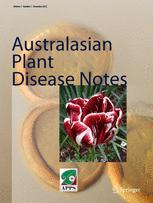Ver ítem
- xmlui.general.dspace_homeCentros e Institutos de InvestigaciónCIAP. Centro de Investigaciones AgropecuariasInstituto de Patología VegetalArtículos científicosxmlui.ArtifactBrowser.ItemViewer.trail
- Inicio
- Centros e Institutos de Investigación
- CIAP. Centro de Investigaciones Agropecuarias
- Instituto de Patología Vegetal
- Artículos científicos
- Ver ítem
Papaya ringspot virus W infecting Luffa aegyptiaca in Cuba
Resumen
Luffa aegyptiaca (sponge gourd) plants showing severe leaf mosaic and deformation symptoms were observed in Villa Clara, Cuba. Electron microscopy observations of leaf dip preparations revealed flexuous filamentous particles, which were identified as Papaya ringspot virus (PRSV) by ELISA test. PRSV was mechanically transmitted to healthy Cucurbita moschata plants. Sequence analysis of the RT-PCR product obtained from the capsid protein gene showed highest
[ver mas...]
Luffa aegyptiaca (sponge gourd) plants showing severe leaf mosaic and deformation symptoms were observed in Villa Clara, Cuba. Electron microscopy observations of leaf dip preparations revealed flexuous filamentous particles, which were identified as Papaya ringspot virus (PRSV) by ELISA test. PRSV was mechanically transmitted to healthy Cucurbita moschata plants. Sequence analysis of the RT-PCR product obtained from the capsid protein gene showed highest identity with other PRSV isolates from United States of America, Australia, Venezuela, Brazil, India and Cuba, ranging between 93.2–96.5% and 93.4–98.1% for nucleotide and amino acid sequences, respectively. Phylogenetic analysis showed two main clusters. Cluster I included isolates from the Americas-Australia group and India, including sponge gourd isolate, while the cluster II included isolates from China, Thailand and Taiwan. To our knowledge, this is the first report of PRSV-W infecting sponge gourd in Cuba.
[Cerrar]

Autor
Fuente
Australasian plant disease notes 12 : 5. (December 2017)
Fecha
2017-12
Editorial
Springer
ISSN
1833-928X (Online)
Formato
pdf
Tipo de documento
artículo
Palabras Claves
Derechos de acceso
Restringido
 Excepto donde se diga explicitamente, este item se publica bajo la siguiente descripción: Creative Commons Attribution-NonCommercial-ShareAlike 2.5 Unported (CC BY-NC-SA 2.5)
Excepto donde se diga explicitamente, este item se publica bajo la siguiente descripción: Creative Commons Attribution-NonCommercial-ShareAlike 2.5 Unported (CC BY-NC-SA 2.5)
Metadatos
Mostrar el registro completo del ítemÍtems relacionados
Mostrando ítems relacionados por Título, autor o materia.
-
Relative incidence of cucurbit viruses and relationship with bio-meteorological variables
Pozzi, Elizabeth Alicia; Bruno, Cecilia Inés; Luciani, Cecilia; Celli, Marcos Giovani; Conci, Vilma Cecilia; Perotto, Maria Cecilia (Springer, 2020-02)Environmental heterogeneity can shape the plant-virus relationship, furthering the appearance of new diseases in crops, or altering disease incidence and severity. In this work, we studied the virus association with ... -
Enfermedades del Poroto
Ploper, Leonardo Daniel; González, Victoria del V.; Rodriguez Pardina, Patricia; Díaz, Cecilia G.; Vizgarra, Oscar N. (Asociación Argentina de Fitopatólogos, 2024)El género Phaseolus (familia Fabaceae) está compuesto por más de 70 especies botánicas originarias de Mesoamérica y América del Sur. Incluye varias especies de interés hortícola, entre las que se pueden mencionar P. vulgaris ... -
Virosis en zapallito de tronco
Perotto, Maria Cecilia (EEA San Pedro, INTA, 2022)Las principales virosis que afectan al zapallito redondo son las producidas por virus del género Potyvirus. Hay 4 especies de este grupo presentes en Argentina, estos son: Watermelon mosaic virus (WMV), Zucchini yellow ...

